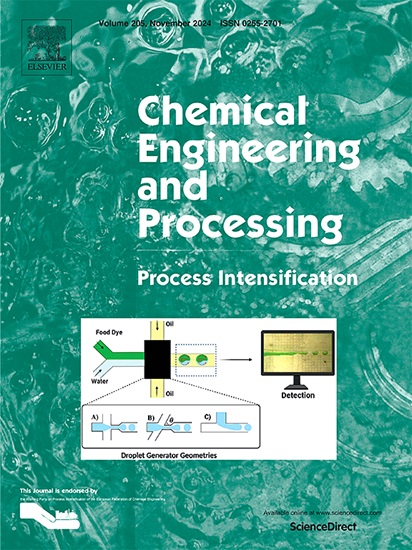循环反应器喷射器和反应釜内的流动和传质性能:CFD-PBM分析
IF 3.8
3区 工程技术
Q3 ENERGY & FUELS
Chemical Engineering and Processing - Process Intensification
Pub Date : 2025-05-29
DOI:10.1016/j.cep.2025.110378
引用次数: 0
摘要
循环反应器以其卓越的气液混合和传质能力而闻名,但在甲醇羰基化的背景下,特别是在喷射器混合管和反应釜内的传质性能方面,研究较少。本研究以年产25万吨醋酸为目标,利用CFD-PBM方法评估了循环反应器的关键性能指标,如气含率和Sauter平均气泡直径,并计算了传质系数。在保持喷射器其他结构参数优化不变的情况下,混合管末端传质系数随管长先增大,在HT/DT = 1处达到峰值,然后减小;同时,气含率随混合管长度的增加而减小。对于以喷射器出口条件为入口的反应釜,高径比和喷射器数量的增加会导致Sauter平均气泡直径增大,从而降低传质效率。值得注意的是,将喷射器定位在r/ r = 0.6时,可以产生最小的气泡尺寸,从而最大化传质效率。本文章由计算机程序翻译,如有差异,请以英文原文为准。

Flow and mass transfer performance in the ejector and reaction kettle of a loop reactor: A CFD-PBM Analysis
Loop reactors, recognized for their exceptional gas-liquid mixing and mass transfer capabilities, have been less explored in the context of methanol carbonylation, particularly regarding mass transfer performance within the ejector mixing tube and reaction kettle. This study, aimed at an annual acetic acid production of 250,000 tons, evaluates key performance metrics of the loop reactor—such as gas holdup and Sauter mean bubble diameter—using the CFD-PBM method and calculates the mass transfer coefficient. By keeping other structural parameters of the ejector optimized and constant, the findings reveal that the mass transfer coefficient at the end of the mixing tube initially increases with tube length, peaks at HT/DT = 1, and then declines. Meanwhile, gas holdup decreases as the mixing tube length increases. For the reaction kettle, modeled using the ejector outlet conditions as the inlet, an increase in the height-to-diameter ratio and the number of ejectors results in a larger Sauter mean bubble diameter, thereby reducing mass transfer efficiency. Notably, positioning the ejector at r/R = 0.6 produces the smallest bubble size, maximizing mass transfer effectiveness.
求助全文
通过发布文献求助,成功后即可免费获取论文全文。
去求助
来源期刊
CiteScore
7.80
自引率
9.30%
发文量
408
审稿时长
49 days
期刊介绍:
Chemical Engineering and Processing: Process Intensification is intended for practicing researchers in industry and academia, working in the field of Process Engineering and related to the subject of Process Intensification.Articles published in the Journal demonstrate how novel discoveries, developments and theories in the field of Process Engineering and in particular Process Intensification may be used for analysis and design of innovative equipment and processing methods with substantially improved sustainability, efficiency and environmental performance.

 求助内容:
求助内容: 应助结果提醒方式:
应助结果提醒方式:


